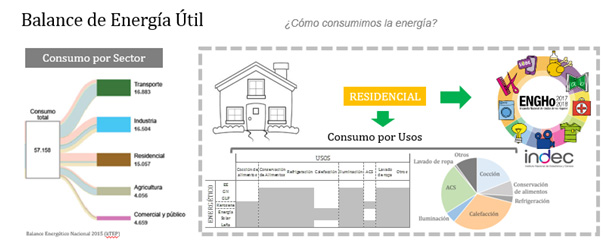One of the most used definitions of Useful Energy qualifies it as the energy made available to the consumer after its last conversion. OLADE considers that the useful energy (EU) is the energy available after the system use for the production of goods or services, once all the transformation and transport losses associated to it have been discounted. The energy source must undergo a transformation to achieve the form of energy suitable for consumer use. In this way, the useful energy is the difference between the energy that is made available to the consumer and the total losses taking place during the final consumption. Some of the most common end uses are: carrying out a job, obtaining heat, obtaining certain physical or chemical processes, cooling and conditioning spaces, mechanical movement and lighting. The Final Energy (EF), on the other hand, is the energy made available to the consumer before its last conversion, and that must undergo a transformation to achieve a suitable form for its use, and it is the energy registered in the current energy balances.
EIn the conventional energy balances of final energy consumption, energy accounting can
determine the quantities of each source used in each sector. For example, the National
Energy Balance lists the quantity of electricity used each year by the residential sector, the
annual quantity of natural gas used by networks, as well as the quantities of liquefied gas,
firewood, coal and kerosene.
The Useful Energy Balance disaggregates these consumptions for the different uses: how
much energy is used for cooking, washing clothes, for lighting, etc.
Indeed, "the balance of the useful energy is the accounting of the energy flows,
considering the lower calorific value of the energy sources, from the primary supply to the
useful energy recovered by the final consumer at the output of their consumer devices,
thus registering the losses undergone in the different phases of the energy chain
(production, transport, transformation and consumption)" (OLADE, 2017: 2), being a
balance derived from the balance of final energy.
In the following image, you can observe how the useful energy balance of the residential
sector collects information for the different uses, for energy.
